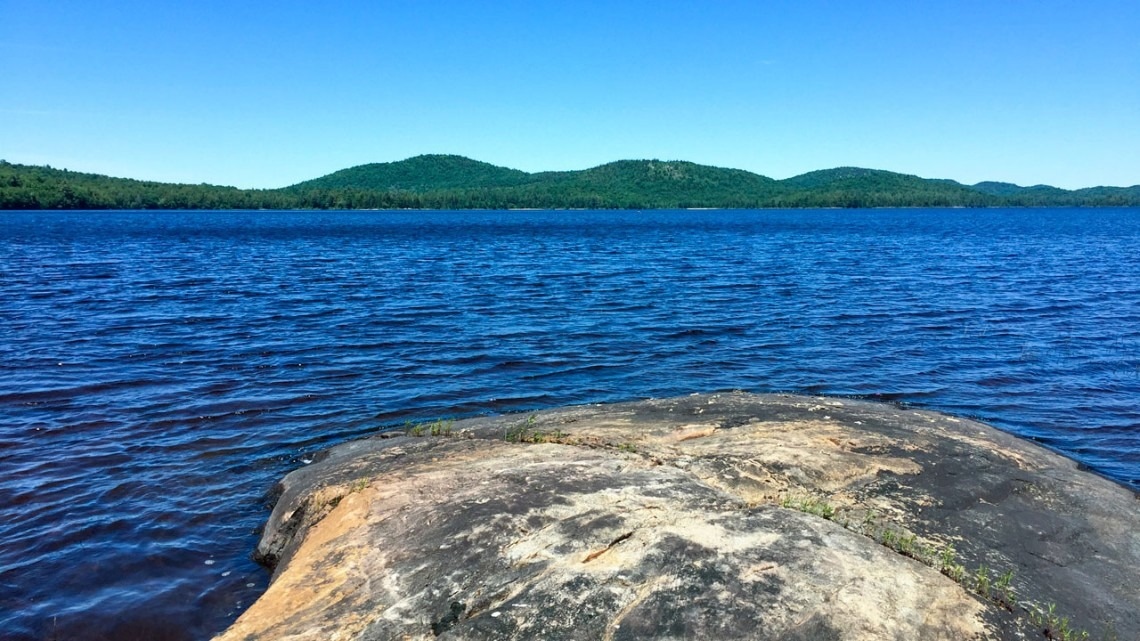A typical example of Adirondack Park water is Rondaxe Lake in Herkimer County, New York. However, Rondaxe, like thousands of lakes in temperate zones around the world, has been losing a global-warming battle to keep oxygen in its waters during the last quarter-century.
 Under a cloudless blue sky, Lake Lila gleams in the William C. Whitney Wilderness Area in Adirondack Park, New York. Lakes like this are becoming susceptible to oxygen loss, thanks to a warming world. Image Credit: Stephen Jane/Provided.
Under a cloudless blue sky, Lake Lila gleams in the William C. Whitney Wilderness Area in Adirondack Park, New York. Lakes like this are becoming susceptible to oxygen loss, thanks to a warming world. Image Credit: Stephen Jane/Provided.
According to new Cornell and Rensselaer Polytechnic Institute research, a constantly warming world is causing prolonged late-summer weeks of water stratification, which causes oxygen deprivation in the water - creating conditions known as hypoxia (low oxygen) and anoxia (no oxygen) - and negative consequences for fish and other species.
The findings were published in the journal Global Change Biology on December 6th, 2022.
Lakes with dissolved oxygen losses strongly outnumber those with gains. At large scales, aerobic organisms are losing available habitat as warming of lakes continues. This is particularly the case for organisms that rely on well-oxygenated cool waters deep in lakes to survive warm periods.
Stephen Jane, Study Lead Author and Postdoctoral Fellow, Cornell Atkinson Center for Sustainability
Jane and his co-workers studied over 25 years of data from over 400 lakes, predominantly in the United States, to determine dissolved oxygen loss. In addition to Rondaxe Lake, the group investigated the reservoirs of New York's Neversink (Sullivan County) and Cannonsville (Delaware County), as well as Hamilton County’s Jockeybush and Sagamore lakes.
The researchers discovered that the percentage of low-oxygen water in temperate climate lakes is increasing by 0.9 % to 1.7 % every decade on average and that the volume of lake water devoid of oxygen has risen by more than 50 % in the last decades.
Jane, who works in the Department of Natural Resources and the Environment in the College of Agriculture and Life Sciences, adds, “Oxygen plays a big role in many chemical reactions. By removing oxygen from the water column, in the layers of the lake, you change reactions.”
Reduced oxygen levels in lake water can have a variety of consequences. For example, methane, a potent greenhouse gas, may accumulate in anoxic areas of the water column. Nutrients like phosphorus from agricultural fertilizer may enter the water column due to unsettled lake sediment, increasing the likelihood of hazardous algal blooms.
In a typical July or August, the lake top temperature may be around 70 degrees, while the lake bottom temperature may be around 40 degrees.
Water temperature and density are related. So it becomes a situation where basically you have oil and vinegar, where strong water temperature differences between layers causes resistance to mixing – which is stratification.
Stephen Jane, Study Lead Author and Postdoctoral Fellow, Cornell Atkinson Center for Sustainability
As a result, oxygen from the atmosphere is prohibited from replenishing dissolved oxygen in deep waters, according to Jane. Since winter is concluding earlier, seasonal stratification begins earlier and ends later.
According to Jane, these stratification shifts allow for greater time for deoxygenation - the disruption of the normal oxygenation process—in deep-water habitats.
We show here that as warming is continuing, the amount of time that lakes exhibit stratification is increasing and this leads to increases in the amount of low-oxygen water in lakes. The bad news is that given projected warming rates, we’ll likely see even greater increases in the amount of oxygen-depleted water in lakes in the future.
Kevin Rose, Study Co-Author and Associate Professor, Rensselaer Polytechnic Institute
In addition to Jane and Rose on the research, other Co-Authors are Joshua L. Mincer and Jonathan T. Stetler, Rensselaer Polytechnic Institute; Maximilian P. Lau, Freiberg University of Mining and Technology, Germany; and Abigail S. L. Lewis, Virginia Tech, Blacksburg, Virginia.
The research was funded by the National Science Foundation and by Cornell Atkinson.
Journal Reference:
Jane, S. F., et al. (2022) Longer duration of seasonal stratification contributes to widespread increases in lake hypoxia and anoxia. Global Change Biology. doi.org/10.1111/gcb.16525.